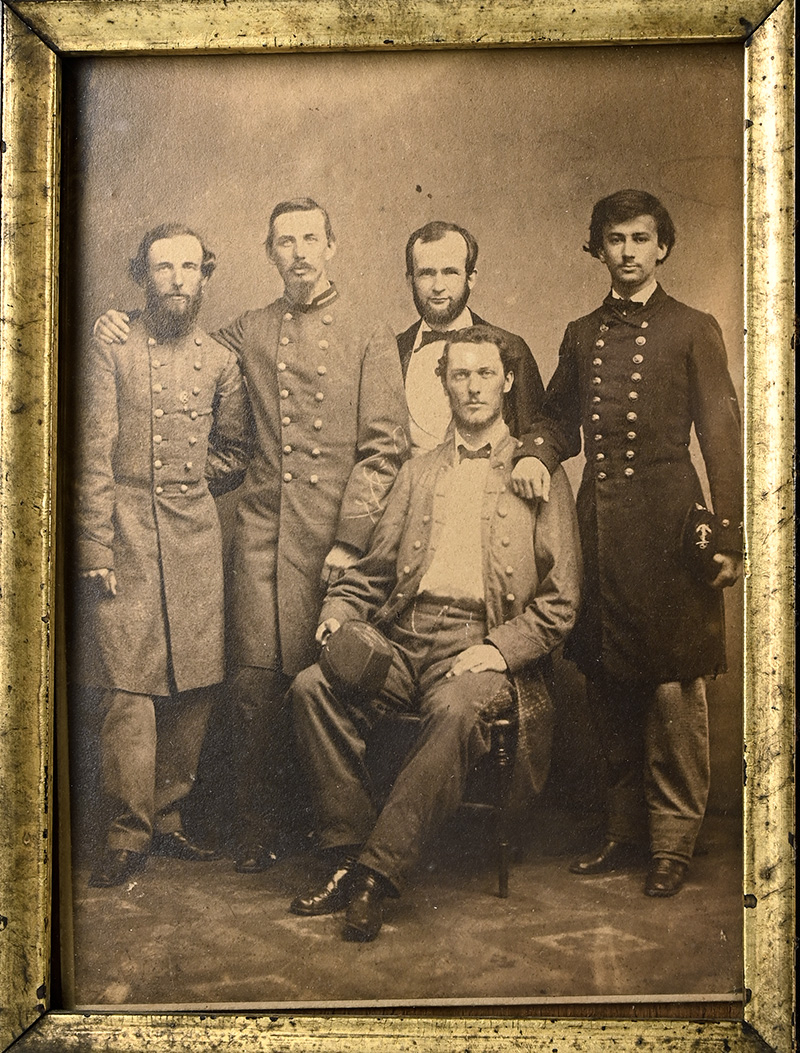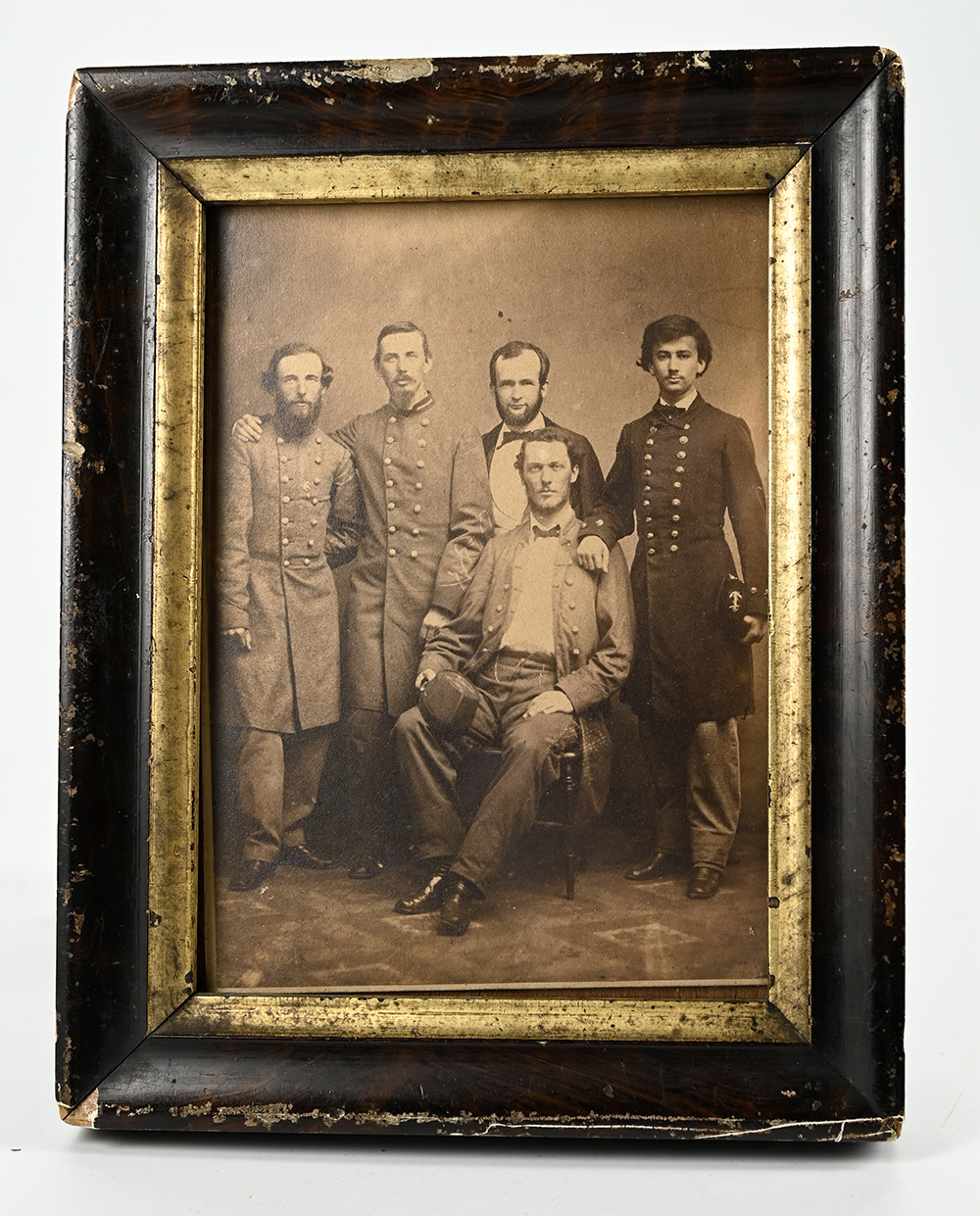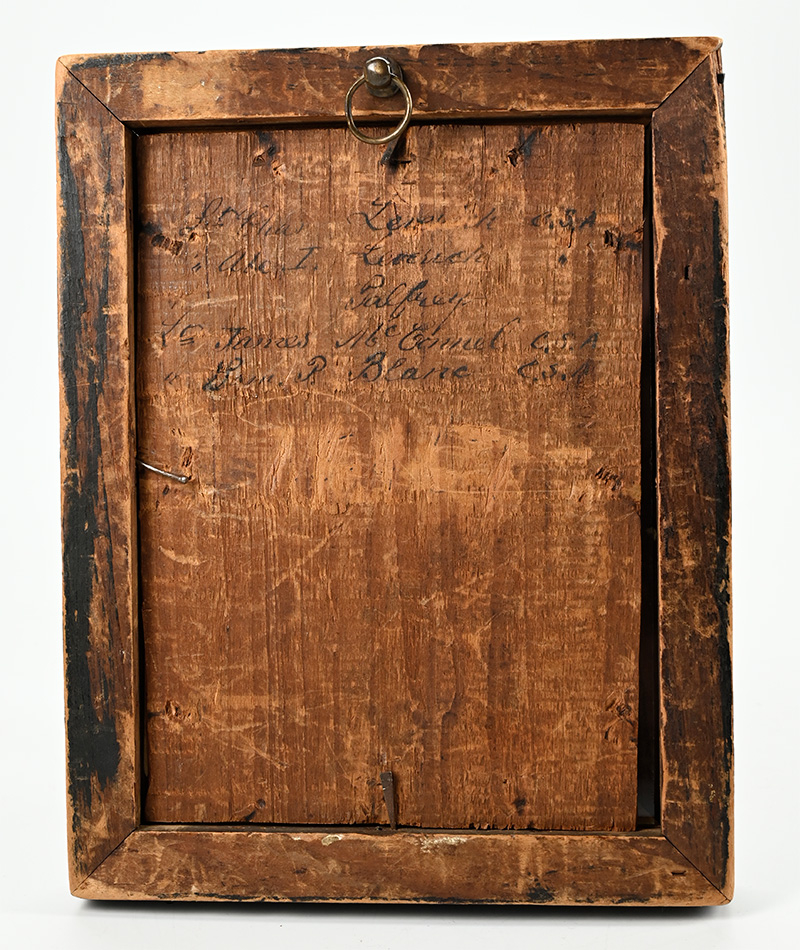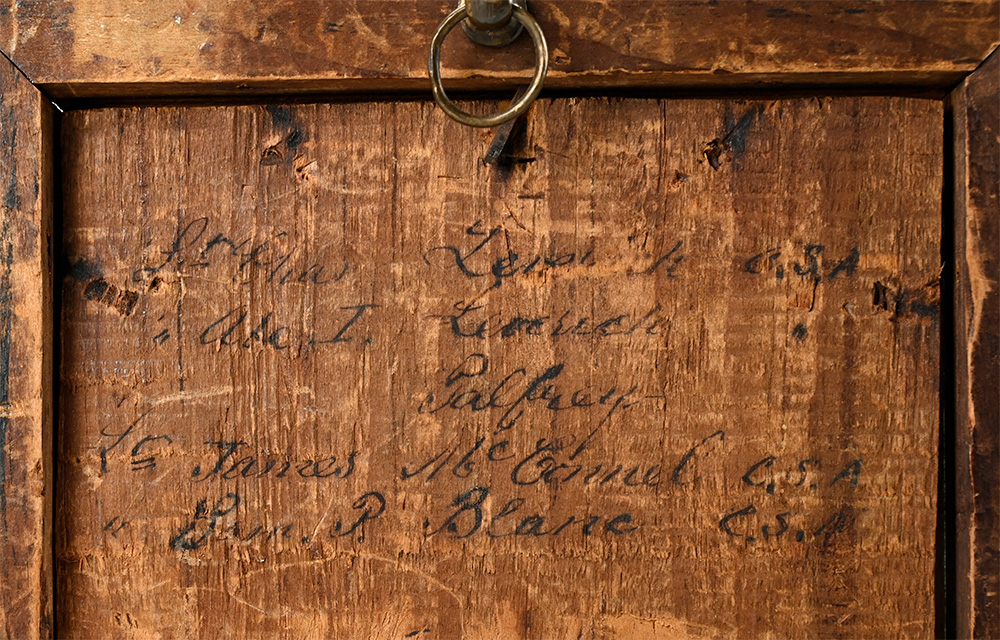site search
online catalog
FIVE IDENTIFIED CONFEDERATE LOUISIANA OFFICERS, WASHINGTON ARTILLERY BADGE AND CS NAVY!

Hover to zoom




$2,950.00 SOLD
Quantity Available: None
Item Code: 1138-2021
This great albumen image comes from the collection of the late Bill Turner, well known Virginia collector and dealer. The image is housed in its original wood frame with back board that has period identifications of the five men shown, four standing and one seated. Three are in C.S. army officer uniforms and one in a C.S. navy uniform. One of the standing figures, behind the seated officer, may be in civilian clothes, and is identified only by last name, but we have a pretty good guess on who he is. Two of the men are brothers, both with service in the Washington Artillery of New Orleans, and one wears the badge of that organization on his left breast. All saw active service.
The image itself is mounted on thin card stock, like a CDV, but is larger, measuring 3 11/16 by 5 inches, including the narrow border, intact around all four sides. The back board is inscribed in period ink, the order from top to bottom corresponding to the men from left to right:
Lt. Chas. Leverich C.S.A.
“ Abe. I. Leverich C.S.A.
Palfrey
Lt. James McConnel C.S.A
“ Sam. P. Blanc
Charles Edward Leverich (1834-1880) and Abram Inskeep Leverich (1836-1896) were brothers, both serving in the Washington Artillery of New Orleans, Charles in the 2nd Company and Abram in the 5th (along with a third brother, Henry or “Hy.”) Charles’s diary, covering 7/6/63 to 9/21/64 is at LSU and might shed light on the date of the image, but we have not had access to it and suspect it may have been taken later in Mobile. We can only say the image must postdate July 1863, when Charles was commissioned.
On his left breast Charles proudly displays a Washington Artillery badge: a belt surrounding a pair of crossed cannons from which hangs a tiger’s head. Since he was commissioned in a different unit, this is a nice display of unit loyalty. He enlisted as a corporal on 26 May 1861 and was present for every engagement of the battery from Bull Run in July 1861 through Williamsport, July 6, 1863: Manassas, Munson’s Hill, Hall’s Hill, Lewinsville, Yorktown, Mechanicsville, Rappahannock Station, 2nd Manassas, Antietam (with his horse killed at Crampton’s Gap,) Fredericksburg, Chancellorsville, and Gettysburg. He is present with the company on all muster rolls except September-October 1861, when his on “special duty” at Manassas, also the time when he was promoted sergeant: 10/1/61. He was discharged for promotion as of 7/4/63, sometimes listed as a promotion to first lieutenant, but elsewhere as “Junior 2nd Lieutenant” in Huwald’s Tennessee Battery of Horse Artillery. This may have been due to battalion commander John Rawl, a Louisianan, for whom Leverich acted as adjutant in November and December, but the battery absorbed Robinson’s Louisiana battery shortly after Chickamauga in September, so there might have been a connection there. In any case, the battery (Huwald’s and later Ramsay’s) served as horse artillery in Forrest's Corps at Chickamauga and then with Wheeler's Corps from April 1864 for the balance of the war.
Charles Leverich’s diary, covering July 1863 to August 1864 is at LSU. According to their summary, after his commission he visited his parents in Georgia, where they were living as refugees from New Orleans, and from Aug. 21, 1863, served “as battery officer for General Simon Bolivar Buckner under General Braxton Bragg during the campaign near Chattanooga, Tennessee. Described are the winter quarters of the Confederate Army at Dalton and Oxford, Georgia, and the armies of General Joseph E. Johnston and John B. Hood . . . changes in military posts, encounters with other units, and skirmishes with Federal troops during the retreat to Atlanta. The diary ends after the capture of Atlanta by Federal forces in 1864.”
Leverich’s service from there to the end of the war are unclear, but would have been interesting if he stayed with the battery. Conflicts between the Tennessee and Louisiana contingents led to the death of a Louisiana officer and assassination attempts on their Tennessee captain. The battery does not seem to have surrendered as a unit and we see no parole documents in his files, so there is room for more research. Given the connections of at least three of the other officers in the photo to Mobile, however, we suspect he also may have served there toward the end of the war. We do know, however, that he survived the war to return to New Orleans, marry in 1866, and rear three children. He died there at age 45 on May 24, 1880.
Abram Inskeep Leverich (1836-1896,) standing next to Charles, had been a corporal in the militia organization of the Washington Artillery and in May 1861 was among those ordered to remain in New Orleans who recruited a fifth company for Confederate service. He is repeatedly mentioned in Hughes’ history of that company. He was formally enlisted in the 5th Company on 6 March 1862, fought at Shiloh and was promoted to 1st Sergeant to date 7 April 1862, and was elected 2nd Lieutenant on 24 July 1862. He commanded a section at Murfreesboro, and fought again at Chickamauga. In 1864 he was lightly wounded at Kennesaw Mountain and in 1865, while the battery was posted in Mobile, was severely wounded in the cheek at the Battle of Spanish Fort (defenses of Mobile) on April 5 and captured when the city fell. His obituary says he made First Lieutenant by war’s end, but we find him only as a Second Lieutenant. After the war he was a businessman in New Orleans. He died of a self-inflicted gunshot wound Dec. 14, 1896. (We should note in passing that images of Abram have sometimes been identified as Charles, likely from the appearance of a last name only on the reverse, though in one case the exact same image is identified differently in the same publication, which we would have thought would have raised concerns. This is nice corrective.)
Standing next to Abram Leverich is a man identified only as “Palfrey.” He wears an open coat closer in color to that of the navy officer. The first impression is that he is in civilian clothes, but shades of color might vary and the officer seated in front of him has his coat open also. His name is listed only as “Palfrey.” We suspect this is Lt. William Palfrey of the 1st Louisiana Artillery: 2nd Lieutenant Co. A in May 1862 and posted to Vicksburg, 1st Lieutenant January 1863, with rank from Nov. 22, 1862, and with service also in Companies D and H; captured at Vicksburg in July, exchanged in December, and transferred to Gen. Shoup’s staff at Mobile as AAAG January 1864.
This identification of Palfrey is strengthened by the Louisiana, and the Mobile, connections of the other men, most strongly of Lt. James McConnell, seated directly in front of him, who was a fellow officer in the 1st Louisiana Artillery, appointed 2nd Lieutenant of Co. E on March 3, 1863, and, like Palfrey, captured at Vicksburg, paroled (though at first refusing to sign his parole,) exchanged and, like Palfrey, posted to Mobile on detached service from October 1863, where he acted as Assistant Provost Marshal. He was listed still at Mobile in January 1865 and still on detached service in March and April. He was paroled 10 May 1865 as part of the Army of the Department of Alabama, Mississippi and East Louisiana surrendered by Lt Gen Taylor to Canby at Meridian, Miss. He signed himself at that point, “2nd Lt 1st LA Arty & Actg Judge Advocate.”
The fifth officer wears a CS Navy uniform and is identified as “Lt. Sam. P. Blanc.”
Like the others, Samuel P. Blanc a Louisiana native. He enlisted and was commissioned an acting midshipman in the CS Navy 8/29/61 and on 6/2/1864 was promoted to and commissioned a master in the CS Provisional Navy (the former being the CS regular navy and the latter the wartime navy of volunteer forces.) In 1861-62 he was on the CSS McCrea at the New Orleans Station, the gunboat defending the lower Mississippi and taking part in the fight at Head of Passes in October 1861 and the battle at Forts Jackson and St. Phillip in which she was critically damaged but the “only thing afloat with the Confederate flag flying the next morning.” The ship was permitted by Farragut to take a load of wounded to New Orleans, where she was scuttled.
Blanc also shows up on the rolls of Fort Polk, Mississippi River in 1862, and in 1862 and 1863 was on board the CSS Baltic, CSS Savannnah, and CSS Patrick Henry; in 1864 he served on CSS Chattahoochee, CSS Nashville, CSS Sampson, and CSS Hornet (a torpedo launch) at a date not stated. In late April 1865 he was aboard the CSS Webb under the command of the redoubtable Charles S. Read, when they broke through the federal blockade of the Red River defenses and made it past New Orleans when they were forced to beach and destroy the ship rather than face the USS Richmond. He was interned at Fort Warren in Boston Harbor, from which was released 6/13/65 on signing the oath of allegiance. We note that one of Blanc’s ships, the CSS Nashville, was outfitted in Mobile in 1864, which further raises the potential of Mobile as the location for the image.
This is a wonderful image, worthy of a top position in a sophisticated collection, with great connections to the Washington Artillery, Vicksburg, Mobile, both the Army of Northern Virginia and Army of Tennessee, and, needless to say, Louisiana. [sr] [ph:m]
~~~~~~~~~~~~~~~~~~~~~~~~~~~~~~~~~~~
THIS ITEM, AS WITH ALL OTHER ITEMS AVAILABLE ON OUR WEB SITE,
MAY BE PURCHASED THROUGH OUR LAYAWAY PROGRAM.
CLICK HERE FOR OUR POLICIES AND TERMS.
THANK YOU!
Inquire About FIVE IDENTIFIED CONFEDERATE LOUISIANA OFFICERS, WASHINGTON ARTILLERY BADGE AND CS NAVY!
Most Popular
Historical Firearms Stolen From The National Civil War Museum In Harrisburg, Pa »
Theft From Gravesite Of Gen. John Reynolds »
Selection Of Unframed Prints By Don Troiani »
Fine Condition Brass Infantry Bugle Insignia »
featured item
CONFEDERATE CAVALRY SABER BY FROELICH
This is a very early and possibly unique Confederate cavalry saber, possibly even a cavalry officer’s saber, by Louis Froelich. It uses a crudely cast, heavy, thick guard, with the side branches branching off from the knucklebow at two different… (870-614). Learn More »
site search
Upcoming Events
The shop is currently closed so that we may conduct our annual inventory. We are available by phone… Learn More »


